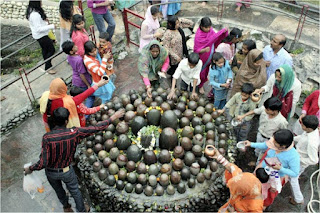Maha Shivaratri is a Hindu festival celebrated before the arrival of spring that marks the “Great Night of Shiva,” a Hindu deity. It is a major holiday in Hinduism, a solemn remembrance of overcoming darkness and ignorance. Because the holiday is based on the Hindu Lunar Calendar, the date it is celebrated changes each year.
History of Maha Shivaratri
Legend has it that a poison came out of the ocean during Samundra Manthan. In order to protect the citizens, Shiva drank the poison, but it did not kill him. Instead, it caused his throat to “burn blue.” The day is a public holiday in Nepal with offices, schools and businesses closed to honour Shiva.

Traditions and Celebrations
Thousands of visitors come to the Pashupatinath Temple to celebrate Maha Shivaratri and the Shiva Shakti Peetham nearby. The temple is dedicated to Lord Shiva in the form of Pashupati, Lord of the Animals. Legend has it that Lord Shiva roamed as a deer in the forests in the area. The temple is open only to Hindus with several shrines and pavilions where yogis and priests chant or meditate.
In the days before the holiday, people fill the roads around the temple and there are vendors selling red tika powder or sacred beads. The day of the holiday there is a military parade to honour Lord Shiva as well.
Unlike most Hindu festivals which take place during the day, Maha Shivaratri is celebrated at night. There are all night vigils and prayers representing Shiva’s ability to overcome darkness and ignorance. Many spend the night around the temple, lighting sacred fires, singing praises to Lord Shiva and keeping vigil to welcome his descent to Earth.
The official celebration begins at midnight with priests offering items to Lord Shiva in the temple. People swim in the sacred Bagmati River, carrying water in cupped palms to offer it to the stone stele which is the symbol of Lord Shiva. In the morning, sacred texts are recited until noon when people begin singing sacred songs. Some of the finest musicians and singers come to Nepal to sing praises of Shiva.
It is not unusual to see yogis or sadhus sitting naked, covered with ash or smoking marijuana during the festival. Although marijuana is illegal in Nepal, it is permitted for religious rituals during the festival. It is believed that after Shiva’s consort died, he came to the forests near the temple, smeared with ash, wearing a serpent and draped in a tiger skin. While there, he smoked marijuana which grows wild in the forests.
History of Maha Shivaratri
Legend has it that a poison came out of the ocean during Samundra Manthan. In order to protect the citizens, Shiva drank the poison, but it did not kill him. Instead, it caused his throat to “burn blue.” The day is a public holiday in Nepal with offices, schools and businesses closed to honour Shiva.

Traditions and Celebrations
Thousands of visitors come to the Pashupatinath Temple to celebrate Maha Shivaratri and the Shiva Shakti Peetham nearby. The temple is dedicated to Lord Shiva in the form of Pashupati, Lord of the Animals. Legend has it that Lord Shiva roamed as a deer in the forests in the area. The temple is open only to Hindus with several shrines and pavilions where yogis and priests chant or meditate.
In the days before the holiday, people fill the roads around the temple and there are vendors selling red tika powder or sacred beads. The day of the holiday there is a military parade to honour Lord Shiva as well.
Unlike most Hindu festivals which take place during the day, Maha Shivaratri is celebrated at night. There are all night vigils and prayers representing Shiva’s ability to overcome darkness and ignorance. Many spend the night around the temple, lighting sacred fires, singing praises to Lord Shiva and keeping vigil to welcome his descent to Earth.
The official celebration begins at midnight with priests offering items to Lord Shiva in the temple. People swim in the sacred Bagmati River, carrying water in cupped palms to offer it to the stone stele which is the symbol of Lord Shiva. In the morning, sacred texts are recited until noon when people begin singing sacred songs. Some of the finest musicians and singers come to Nepal to sing praises of Shiva.
It is not unusual to see yogis or sadhus sitting naked, covered with ash or smoking marijuana during the festival. Although marijuana is illegal in Nepal, it is permitted for religious rituals during the festival. It is believed that after Shiva’s consort died, he came to the forests near the temple, smeared with ash, wearing a serpent and draped in a tiger skin. While there, he smoked marijuana which grows wild in the forests.

Post a Comment